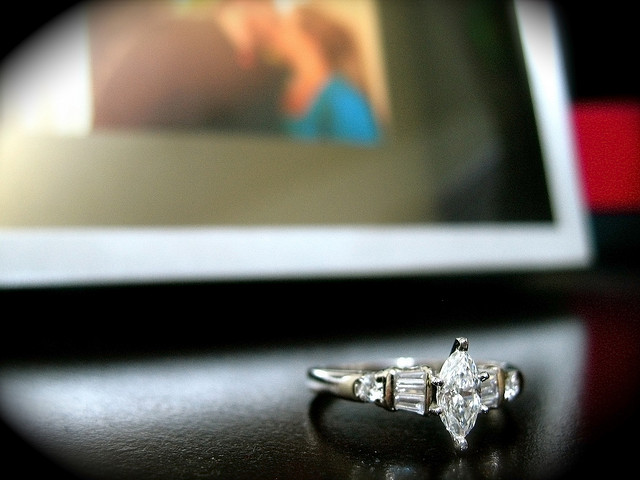“Stuff” doesn’t equate to love, and most Postconsumers will be among the first to tell you that. But for some reason, an area where the idea that “stuff” and “how much somebody loves you” seem to be the equivalent of each other in our culture is the idea of an engagement ring. The often huge size and lavish cost of engagement rings are somehow held up as an indication of the extent to which a future betrothed is loved by her partner. Debt is incurred. Fights are had. And suddenly the idea that “all you need is love” is thrown out of the window. But does the size of the engagement ring really have anything to do with your future happiness? The answer may surprise you.
First, a Brief History of the Engagement Ring
And by brief, we do mean brief since the entire history of the engagement ring tradition is quite long. We’re also going to focus on the western tradition of just the woman wearing an engagement ring – even though there are many world cultures where both the man and the woman wear engagement rings. The first verifiable mention of engagement rings for women happened in Ancient Rome – and no, it was not considered part of the bride price as has been made popular belief. The engagement ring was placed on the finger closest to the little finger on the left hand because that finger was believed to have a vein that went right to the heart. The first documented use of a diamond engagement ring was in Austria in 1477 during the Renaissance. Of course, once an upper class duke used a diamond engagement ring, it became the standard to live up to. We guess “keeping up with the Joneses” isn’t a new phenomenon!
However, the real prevalence of diamonds in engagement rings began during the Victorian era when diamonds were discovered in “colonized” South Africa. The mine output of diamonds by 1872 exceeded one million karats, which made diamond jewelry and rings much more accessible to people. You can thank diamond cartel De Beers for the contemporary obsession with diamond engagement rings though (and you can judge them harshly for it, too). After market research indicated that engagement rings were going out of fashion with a younger generation after the Great Depression, De Beers launched a marketing campaign that you’re still familiar with today: A Diamond is Forever. And indeed, their ability to create consumer demand for diamond engagement rings was effective. (If Postconsumers.com could fund a huge marketing campaign the way we’re trying to do, it could even be called Get Satisfied Forever, a mental and environmental game-changer.)
What’s the Average Size and Cost of an Engagement Ring?
The average cost of a wedding ring can vary dramatically – and to be honest it’s not the actual dollar sign that we think sends a bad consumer message. It’s the “rule” that’s typically applied to how much an engagement ring should cost, which is commonly thought to be three months of his salary. Three months of his salary? For a thing? Let’s just say that no matter how liberal we are about the idea that postconsumerism means finding your own place on the consumer spectrum, we should all be able to agree that spending three months of salary on a ring is certainly a consumer media machine manipulation designed to get you to spend more money. And here’s the best part – it probably doesn’t mean you’re going to be any happier than if you hadn’t.
The Relationship Between Engagement Ring Cost and Happy Marriages
In October of 2014, two researchers from Emory University, Andrew M. Francis and Hugo M. Mailon, released their study, “A Diamond is Forever” and Other Fairy Tales: The Relationship Between Wedding Expense and Marriage Duration. The study covered a sample size of 3000 mixed-sex marriages and came to two larger conclusions. Men who spent between $2000 and $4000 on an engagement ring were 1.3 times more likely to get divorced than men who spent between $500 and $2000. And that data isn’t even beginning to touch the upper end of engagement ring costs! We will fully disclose that men who spent less than $500 also led to higher divorce rates. But the data clearly shows that the bigger the rock does not necessarily mean the greater the love.
The study also showed that having a wedding that cost more than $20,000 correlated with a divorce rate that was 3.5 times higher for women than for those who spent between $5000 and $10,000. Given that the average cost of an American wedding is $30,000, that explains a lot about the divorce rate!
A Quick Note on Buying Diamond Engagement Rings
Like with anything else, what you choose to spend and how you spend it is your business. But if you’re planning to buy an engagement ring in the future (congratulations!) we’d love to encourage you to take a quick look at our tips for making sure that you buy an ethical and environmentally sound engagement ring.
At the end of the day, no matter how shocked we were at the three month “rule”, your beliefs about how much is and isn’t appropriate to spend on an engagement ring are up to you. What we know is this: Postconsumers already realize that “stuff” isn’t equivalent to love. That means that you’re already in a better position to focus on finding the satisfaction of enough in a successful marriage!
Did we miss a fact or opinion on engagement rings and happiness that you want to share with us? If so, just tell us about it on one of the social media channels below.
Facebook | Twitter | Instagram | Tumblr | Pinterest | Google+





